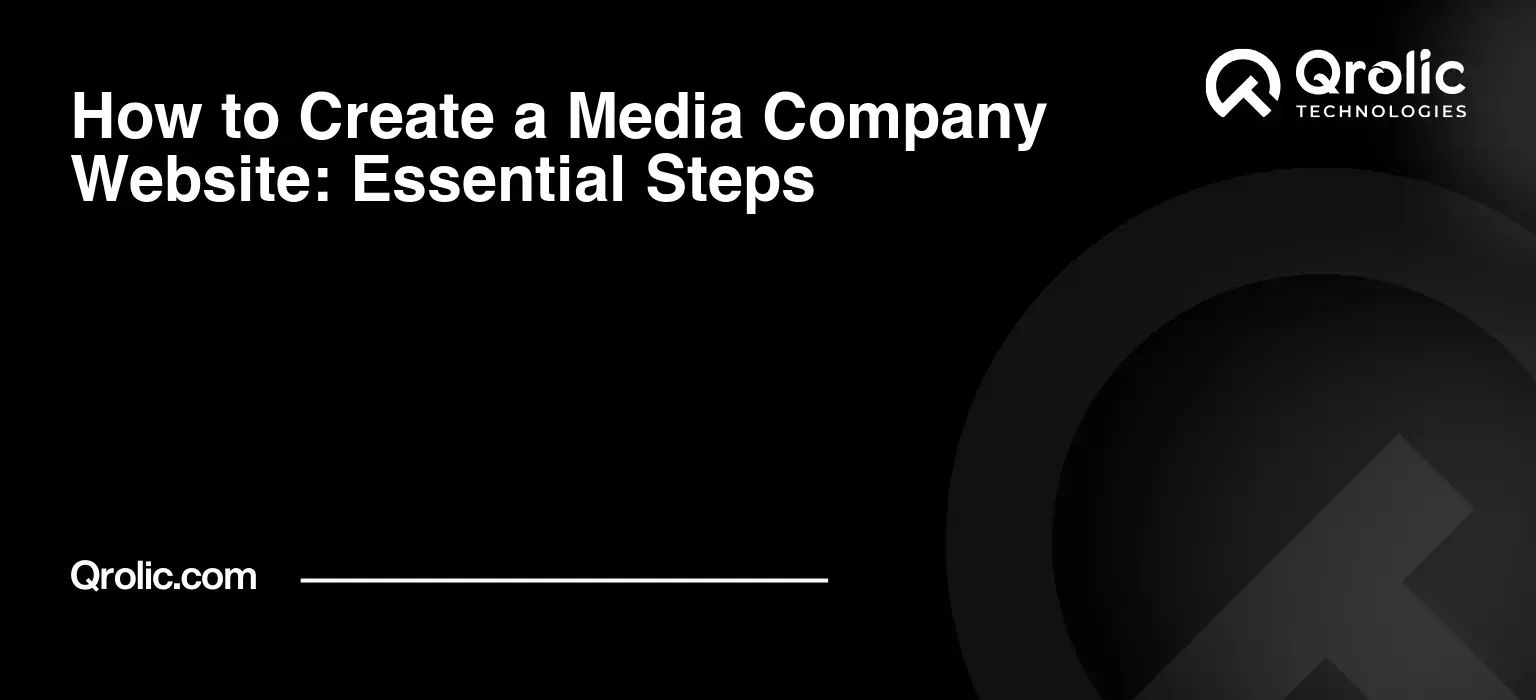Quick Summary:
- Plan your website strategy thoroughly first.
- Design a user-friendly, mobile-responsive site.
- Create quality content and optimize for search.
- Test, launch, and regularly maintain your site.
Table of Contents
- Understanding the Foundation: Why Your Media Company Needs a Killer Website
- Establishing Credibility and Authority
- Showcasing Your Portfolio and Expertise
- Generating Leads and Acquiring Clients
- Building Your Brand and Community
- Analyzing Performance and Optimizing Results
- Phase 1: Planning and Strategy – Defining Your Digital Blueprint
- 1. Define Your Target Audience: Knowing Who You’re Talking To
- 2. Identify Your Unique Value Proposition (UVP): What Makes You Different?
- 3. Establish Clear Goals and Objectives: What Do You Want to Achieve?
- 4. Conduct Competitor Analysis: Learning From the Best (and Worst)
- 5. Develop a Content Strategy: Planning Your Digital Storytelling
- Phase 2: Design and Development – Building Your Digital Stage
- 1. Choosing the Right Platform: WordPress vs. Other Options
- 2. Selecting a Theme or Designing a Custom Website: Appearance Matters
- 3. Designing a User-Friendly Interface (UI): Making Navigation Intuitive
- 4. Developing Essential Functionality: Features That Matter
- 5. Ensuring Mobile Responsiveness: Reaching Users on All Devices
- Phase 3: Content Creation and SEO – Attracting Your Audience
- 1. Keyword Research and Optimization: Speaking the Language of Search Engines
- 2. Crafting High-Quality Content: Engaging, Informative, and Shareable
- 3. Optimizing Meta Descriptions and Title Tags: Enticing Clicks From Search Results
- 4. Building Internal and External Links: Connecting Your Digital Ecosystem
- 5. Ensuring Website Speed and Mobile-Friendliness: Delivering a Seamless Experience
- Phase 4: Testing, Launch, and Maintenance – Ensuring Long-Term Success
- 1. Thoroughly Testing Your Website: Finding and Fixing Bugs
- 2. Launching Your Website: Making it Live to the World
- 3. Monitoring Website Performance: Tracking Key Metrics
- 4. Regularly Updating Content and Functionality: Keeping Things Fresh
- 5. Implementing Security Measures: Protecting Your Online Assets
- Qrolic Technologies: Your Partner in Digital Media Design and Website Development
- Why Choose Qrolic Technologies?
- Our Services for Media Companies:
- Let Qrolic Technologies Help You Build Your Digital Media Empire
- The Bottom Line: Your Website is Your Digital Calling Card
Understanding the Foundation: Why Your Media Company Needs a Killer Website
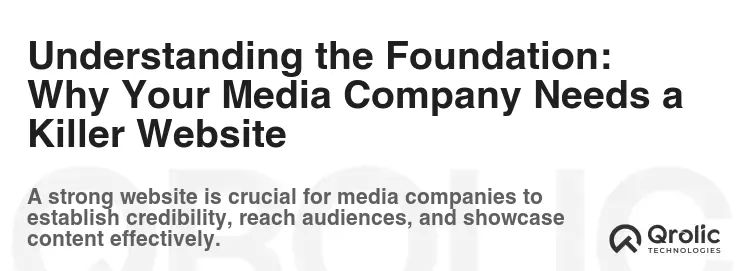
A website isn’t just an online brochure anymore. For a media company, it’s the digital heartbeat, the central hub, the 24/7 broadcasting station that never sleeps. It’s where potential clients, subscribers, and collaborators come to understand who you are, what you do, and why they should care. Before diving into the “how,” let’s solidify the “why” behind a powerful media company website.
Establishing Credibility and Authority
In the fast-paced, constantly evolving world of media, trust is paramount. A professional, well-designed website instantly establishes credibility. It shouts, “We’re serious. We’re experts. We know our stuff.” Think of it as your online portfolio, showcasing your best work, your team’s expertise, and your company’s unique voice. Without it, you risk looking amateurish and losing potential clients to competitors who have invested in their online presence.
Showcasing Your Portfolio and Expertise
This is where the magic happens. Your website allows you to display your best work in a visually appealing and engaging manner. Whether it’s video productions, graphic designs, written content, or social media campaigns, your website is the perfect platform to showcase your talent and demonstrate your capabilities.
- Video Portfolio: Embed your best videos directly on your site, making them easily accessible to potential clients.
- Design Gallery: Create a visually stunning gallery of your graphic design work, highlighting your creativity and attention to detail.
- Written Content Samples: Feature your best articles, blog posts, and copywriting examples, showcasing your writing skills and industry knowledge.
- Case Studies: Develop in-depth case studies that demonstrate how you’ve helped clients achieve their goals, providing concrete evidence of your success.
Generating Leads and Acquiring Clients
Your website should be a lead generation machine. By implementing effective SEO strategies and incorporating clear calls to action, you can turn website visitors into paying clients.
- Contact Forms: Make it easy for potential clients to reach out to you by including prominent contact forms on every page of your website.
- Lead Magnets: Offer valuable resources, such as ebooks, white papers, or free consultations, in exchange for visitors’ contact information.
- Targeted Landing Pages: Create dedicated landing pages for specific services or campaigns, designed to convert visitors into leads.
Building Your Brand and Community
Your website is a powerful branding tool. It allows you to communicate your company’s values, personality, and mission to the world. By creating a consistent brand experience across your website and other marketing channels, you can build a strong brand identity and cultivate a loyal following.
- Brand Story: Share your company’s story, highlighting your history, values, and mission.
- Blog: Publish regular blog posts that showcase your expertise and provide valuable insights to your target audience.
- Social Media Integration: Integrate your social media channels into your website, making it easy for visitors to connect with you on their preferred platforms.
Analyzing Performance and Optimizing Results
Your website provides valuable data that can be used to track your progress and optimize your marketing efforts. By using tools like Google Analytics, you can monitor website traffic, track conversions, and identify areas for improvement. This data-driven approach allows you to continuously refine your website and marketing strategies to achieve better results.
Phase 1: Planning and Strategy – Defining Your Digital Blueprint
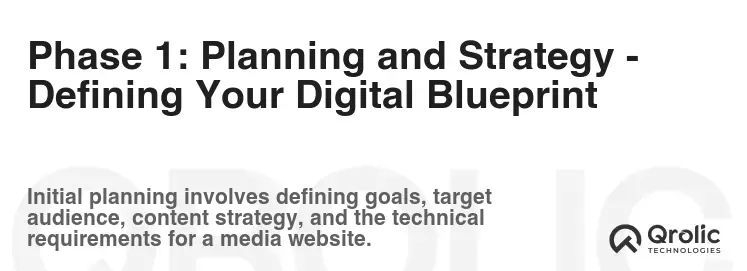
Before you even think about code or color palettes, a solid plan is crucial. This phase is all about understanding who you are, who you’re trying to reach, and what you want to achieve with your media company website.
1. Define Your Target Audience: Knowing Who You’re Talking To
This is arguably the most critical step. Who are you trying to reach? What are their demographics, interests, and pain points? The more specific you can be, the better. For example, instead of saying “businesses,” consider:
- “Small to medium-sized businesses in the tech industry looking to improve their social media presence.”
- “Non-profit organizations seeking affordable video production services for fundraising campaigns.”
Knowing your audience helps you tailor your website’s content, design, and messaging to resonate with them effectively. Use surveys, interviews, and market research to gain a deep understanding of your ideal client.
2. Identify Your Unique Value Proposition (UVP): What Makes You Different?
In a crowded market, you need to stand out. What makes your media company different from the competition? What unique value do you offer to your clients? Your UVP should be clear, concise, and compelling, and it should be prominently displayed on your website.
Examples:
- “We create visually stunning videos that tell your brand’s story and drive results.”
- “We provide affordable and effective social media marketing solutions for small businesses.”
- “We specialize in creating engaging content that converts viewers into loyal customers.”
3. Establish Clear Goals and Objectives: What Do You Want to Achieve?
What do you want your website to achieve? Are you looking to generate leads, increase brand awareness, sell products, or build a community? Setting clear goals will help you measure your success and make informed decisions about your website’s design and functionality.
Examples:
- Increase Website Traffic by 50% in the next six months.
- Generate 10 qualified leads per month through the website.
- Increase brand awareness by 20% in the next year.
4. Conduct Competitor Analysis: Learning From the Best (and Worst)
Don’t reinvent the wheel. Analyze your competitors’ websites to see what they’re doing well and where they’re falling short. This research can provide valuable insights into industry best practices and help you identify opportunities to differentiate your website.
- Identify Key Competitors: Who are your main competitors in the market?
- Analyze Their Websites: What are their strengths and weaknesses?
- Identify Opportunities: How can you differentiate your website from the competition?
5. Develop a Content Strategy: Planning Your Digital Storytelling
Content is king. Your website’s content should be informative, engaging, and optimized for search engines. Develop a content strategy that outlines the topics you’ll cover, the types of content you’ll create, and the frequency with which you’ll publish new content.
- Keyword Research: Identify the keywords your target audience is searching for.
- Content Calendar: Create a schedule for publishing new content.
- Content Types: Determine the types of content you’ll create (e.g., blog posts, videos, infographics).
Phase 2: Design and Development – Building Your Digital Stage
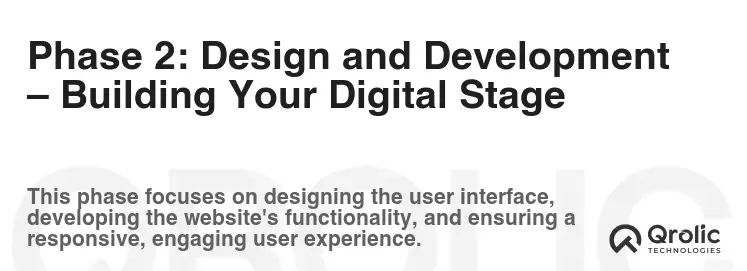
This is where your vision starts to take shape. You’ll be choosing a platform, designing the user interface, and developing the functionality of your website.
1. Choosing the Right Platform: WordPress vs. Other Options
WordPress is the most popular content management system (CMS) in the world, and for good reason. It’s flexible, powerful, and relatively easy to use. However, there are other options to consider, such as Squarespace, Wix, and Webflow.
- WordPress: Highly customizable, SEO-friendly, and offers a wide range of plugins and themes. Requires more technical knowledge.
- Squarespace: User-friendly, visually appealing, and offers a drag-and-drop interface. Less customizable than WordPress.
- Wix: Similar to Squarespace, offers a drag-and-drop interface and a wide range of templates. Can be limiting in terms of SEO and customization.
- Webflow: Powerful design tool that allows for highly customized websites. Requires more technical knowledge.
For most media companies, WordPress is the best choice due to its flexibility, SEO capabilities, and extensive plugin library.
2. Selecting a Theme or Designing a Custom Website: Appearance Matters
Your website’s design should be visually appealing, professional, and aligned with your brand identity. You have two main options:
- Theme: A pre-designed template that you can customize to fit your brand. Themes are generally more affordable and easier to implement.
- Custom Website: A website designed and developed from scratch. Custom websites offer more flexibility and control over the design and functionality.
If you’re on a budget, a well-chosen theme can be a great option. However, if you want a truly unique and customized website, you should consider hiring a professional web designer.
3. Designing a User-Friendly Interface (UI): Making Navigation Intuitive
Your website should be easy to navigate and use. Visitors should be able to find what they’re looking for quickly and easily.
- Clear Navigation: Use a simple and intuitive navigation menu.
- Mobile-Friendly Design: Ensure your website is responsive and looks great on all devices.
- Call to Action: Include clear and prominent calls to action on every page.
- Fast Loading Speed: Optimize your website for speed to ensure a positive user experience.
4. Developing Essential Functionality: Features That Matter
What features does your website need? This will depend on your specific goals and objectives, but some essential features include:
- Contact Form: Allows visitors to contact you directly.
- Blog: Allows you to publish regular blog posts.
- Portfolio: Showcases your best work.
- Social Media Integration: Allows visitors to connect with you on social media.
- E-commerce (if applicable): Allows you to sell products or services online.
5. Ensuring Mobile Responsiveness: Reaching Users on All Devices
In today’s mobile-first world, it’s essential that your website is responsive and looks great on all devices, from smartphones to tablets to desktop computers. A responsive website adapts to the screen size of the device it’s being viewed on, providing an optimal user experience.
Phase 3: Content Creation and SEO – Attracting Your Audience
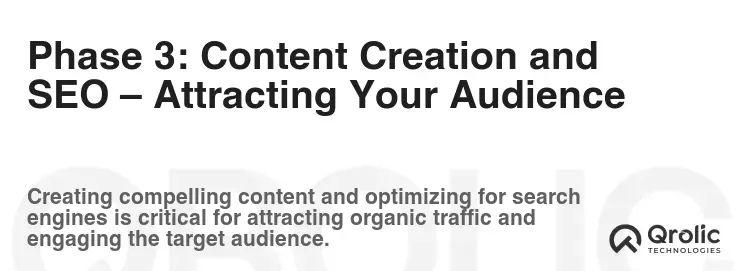
This is where you populate your website with engaging content that attracts your target audience and ranks well in search engines.
1. Keyword Research and Optimization: Speaking the Language of Search Engines
Keyword research is the process of identifying the keywords your target audience is searching for. These keywords should be incorporated into your website’s content, meta descriptions, and title tags.
- Use Keyword Research Tools: Tools like Google Keyword Planner, Ahrefs, and SEMrush can help you identify relevant keywords.
- Focus on Long-Tail Keywords: Long-tail keywords are longer, more specific phrases that are less competitive and can drive highly qualified traffic to your website.
- Incorporate Keywords Naturally: Don’t stuff your content with keywords. Use them naturally and strategically.
2. Crafting High-Quality Content: Engaging, Informative, and Shareable
Your website’s content should be informative, engaging, and shareable. It should also be optimized for search engines.
- Write for Your Audience: Focus on providing value to your target audience.
- Use Clear and Concise Language: Make your content easy to read and understand.
- Incorporate Visuals: Use images, videos, and infographics to break up text and make your content more engaging.
- Promote Your Content: Share your content on social media and other channels.
3. Optimizing Meta Descriptions and Title Tags: Enticing Clicks From Search Results
Meta descriptions and title tags are short snippets of text that appear in search engine results pages (SERPs). They provide a brief summary of your website’s content and should be optimized to entice users to click on your website.
- Write Compelling Meta Descriptions: Use persuasive language and highlight the benefits of visiting your website.
- Use Relevant Keywords: Include relevant keywords in your meta descriptions and title tags.
- Keep it Concise: Meta descriptions should be no more than 160 characters, and title tags should be no more than 60 characters.
4. Building Internal and External Links: Connecting Your Digital Ecosystem
Links are an important ranking factor for search engines. Internal links connect different pages within your website, while external links connect your website to other websites.
- Build Internal Links: Link to relevant pages within your website to improve navigation and SEO.
- Earn External Links: Get links from other websites to improve your website’s authority and ranking.
5. Ensuring Website Speed and Mobile-Friendliness: Delivering a Seamless Experience
Website speed and mobile-friendliness are important ranking factors for search engines. Google prioritizes websites that load quickly and provide a good user experience on mobile devices.
- Optimize Images: Compress images to reduce file size.
- Use a Content Delivery Network (CDN): A CDN distributes your website’s content across multiple servers, reducing loading times.
- Choose a Mobile-Friendly Theme: Ensure your website’s theme is responsive and looks great on all devices.
Phase 4: Testing, Launch, and Maintenance – Ensuring Long-Term Success
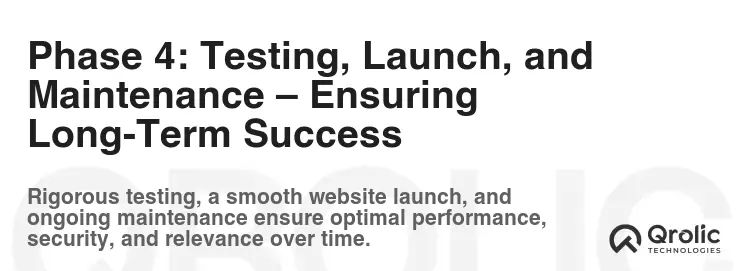
This is the final stretch. You’ll be testing your website, launching it to the world, and implementing a maintenance plan to ensure its long-term success.
1. Thoroughly Testing Your Website: Finding and Fixing Bugs
Before you launch your website, it’s essential to thoroughly test it to identify and fix any bugs or errors.
- Test on Different Browsers and Devices: Ensure your website works correctly on all major browsers and devices.
- Check for Broken Links: Use a link checker to identify and fix any broken links.
- Test Forms and Functionality: Ensure all forms and functionality are working correctly.
- Get Feedback from Others: Ask friends, family, or colleagues to test your website and provide feedback.
2. Launching Your Website: Making it Live to the World
Once you’ve thoroughly tested your website and fixed any bugs, you’re ready to launch it to the world.
- Choose a Domain Name: Select a domain name that is easy to remember and reflects your brand.
- Choose a Hosting Provider: Select a reliable hosting provider that offers good performance and uptime.
- Point Your Domain to Your Hosting: Configure your domain name to point to your hosting server.
- Upload Your Website Files: Upload your website files to your hosting server.
- Announce Your Launch: Promote your website launch on social media and other channels.
3. Monitoring Website Performance: Tracking Key Metrics
After you launch your website, it’s important to monitor its performance to track key metrics and identify areas for improvement.
- Track Website Traffic: Use Google Analytics to track website traffic, page views, and bounce rate.
- Monitor Search Engine Rankings: Track your website’s rankings for relevant keywords.
- Track Conversions: Track the number of leads, sales, or other conversions generated by your website.
4. Regularly Updating Content and Functionality: Keeping Things Fresh
Your website should be regularly updated with fresh content and new functionality to keep visitors engaged and coming back for more.
- Publish New Blog Posts: Regularly publish new blog posts that provide value to your target audience.
- Update Existing Content: Regularly update existing content to ensure it’s accurate and up-to-date.
- Add New Features: Add new features to your website to improve user experience and functionality.
5. Implementing Security Measures: Protecting Your Online Assets
Security is essential for any website. You need to implement security measures to protect your website from hackers, malware, and other threats.
- Use a Strong Password: Use a strong and unique password for your website’s admin account.
- Install Security Plugins: Install security plugins to protect your website from common threats.
- Keep Your Software Up-to-Date: Regularly update your website’s software to patch security vulnerabilities.
- Use an SSL Certificate: An SSL certificate encrypts the data transmitted between your website and visitors, protecting sensitive information.
Qrolic Technologies: Your Partner in Digital Media Design and Website Development

Qrolic Technologies (https://qrolic.com/) understands the unique needs of media companies in the digital age. We offer a comprehensive suite of services designed to help you create a powerful online presence that attracts clients, builds your brand, and drives results.
Why Choose Qrolic Technologies?
- Expertise in Media Industry: We have extensive experience working with media companies of all sizes.
- Custom Website Design and Development: We create visually stunning and user-friendly websites that reflect your brand identity.
- SEO Optimization: We optimize your website for search engines to help you attract more organic traffic.
- Content Creation: We create engaging and informative content that resonates with your target audience.
- Digital Marketing: We help you promote your website and content through effective digital marketing strategies.
- Ongoing Support and Maintenance: We provide ongoing support and maintenance to ensure your website is always running smoothly.
Our Services for Media Companies:
- Website Design and Development: Custom website design, theme customization, e-commerce development, and mobile-friendly design. We ensure your website reflects your brand identity and provides a seamless user experience.
- Digital Media Design: Logo design, branding guidelines, graphic design, video production, and animation. We create visually appealing content that captures your audience’s attention and communicates your message effectively.
- SEO and Content Marketing: Keyword research, content creation, on-page optimization, link building, and social media marketing. We help you attract more organic traffic to your website and establish your brand as a leader in the media industry.
- Website Maintenance and Support: Security updates, software updates, bug fixes, and technical support. We ensure your website is always running smoothly and securely.
Let Qrolic Technologies Help You Build Your Digital Media Empire
Creating a successful media company website requires careful planning, design, and execution. Qrolic Technologies has the expertise and experience to help you build a powerful online presence that attracts clients, builds your brand, and drives results. Contact us today to learn more about how we can help you achieve your digital goals.
The Bottom Line: Your Website is Your Digital Calling Card

Creating a media company website is an investment in your future. A well-designed, informative, and engaging website can help you establish credibility, attract new clients, and build a strong brand. By following the steps outlined in this article, you can create a website that serves as a powerful tool for achieving your business goals. Remember to focus on your target audience, your unique value proposition, and creating high-quality content. And don’t forget to regularly update and maintain your website to ensure its long-term success. With a solid plan and a commitment to excellence, you can create a media company website that stands out from the competition and helps you thrive in the digital age.
